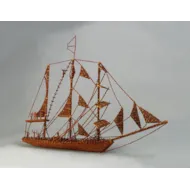A Curious Model of a Three Masted Schooner
A Curious Model of a Three Masted Schooner
Built entirely from cloves, a merchant sailors memento of the Spice Islands
Late 19th Century
Size : 71 cm long, 58.5 cm high – 28 ins long, 23 ins high
Built entirely from cloves, a merchant sailors memento of the Spice Islands
Late 19th Century
Size : 71 cm long, 58.5 cm high – 28 ins long, 23 ins high
The Indonesian Island region once called ‘The Spice Islands’ has been known to traders for their nutmeg and cloves since before 500 BC. Arab, Indian and Chinese merchants sought out the profitable trade in these spices for centuries. In the 4th century BC Han Dynasty rulers required those who addressed them to first chew cloves to freshen their breath. Pliny the Elder complained of the spice trade with Rome that ‘there is no year in which India does not drain the Roman Empire of 50 million sesterces’.
Columbus was in fact searching for the fabled route to the Indies when he arrived at the Americas in 1492, and it was because he believed he had found the Indies that he called the Native Americans ‘Indians’.
By the early 1500’s the individual Sultans of the Maluku Islands amassed great fortunes controlling the spice trade. The demand for and subsequently high prices paid for the spices in Europe drove the merchants to launch expeditions to find new routes to the Islands, and with the discovery and harnessing of the trade winds the control of the new European spice trade was fought over by the Portuguese, Spanish and Dutch in turn. Worth their weight in gold the French eventually succeeded in introducing the clove tree to Mauritius in 1770. Today the majority of the commercial crop is grown in Zanzibar, and cloves are used in virtually every cuisine of the world.
Columbus was in fact searching for the fabled route to the Indies when he arrived at the Americas in 1492, and it was because he believed he had found the Indies that he called the Native Americans ‘Indians’.
By the early 1500’s the individual Sultans of the Maluku Islands amassed great fortunes controlling the spice trade. The demand for and subsequently high prices paid for the spices in Europe drove the merchants to launch expeditions to find new routes to the Islands, and with the discovery and harnessing of the trade winds the control of the new European spice trade was fought over by the Portuguese, Spanish and Dutch in turn. Worth their weight in gold the French eventually succeeded in introducing the clove tree to Mauritius in 1770. Today the majority of the commercial crop is grown in Zanzibar, and cloves are used in virtually every cuisine of the world.
A Curious Model of a Three Masted Schooner

SOLD



